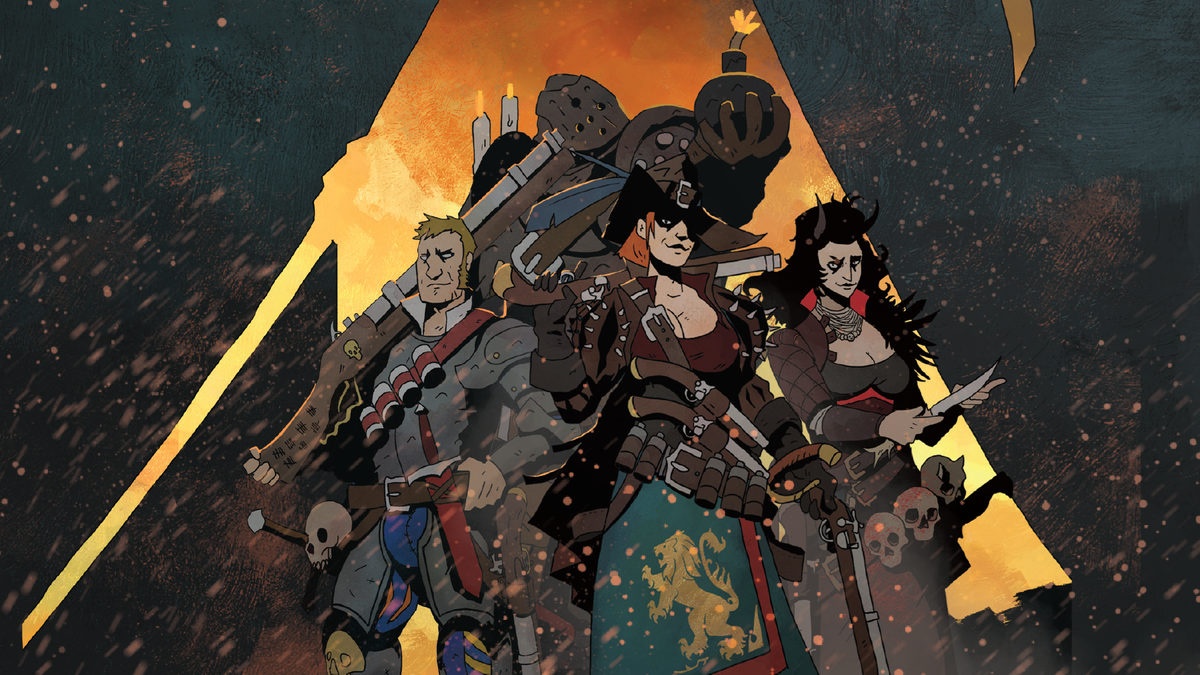
Black Powder and Brimstone, a gothic horror take on the 30 Years’ War, shows us that even the Mork Borg engine can only take you so far. Mork Borg was a revolutionary game, making it seem easy to tweak and modify or create supplements for. Black Powder and Brimstone’s visuals and ideas come with plenty of flair, but the rules and lore writing can’t carry the weight of either. So many sections are founded on ambiguity that could derail or ruin a game. Despite the high quality atmosphere and art design, I can’t see myself ever playing this game.
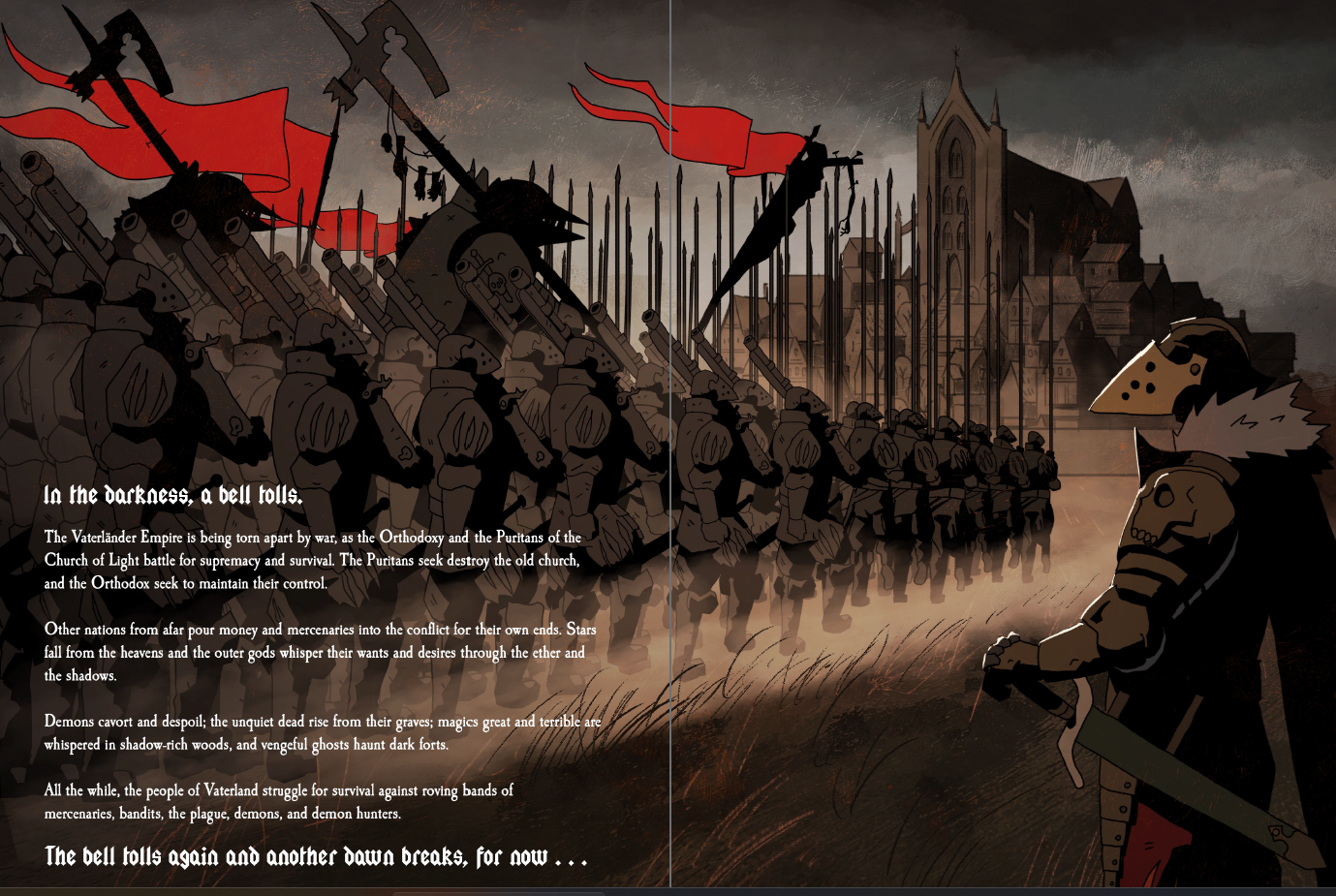
Presentation & Layout
Ben Tobitt’s art truly is exceptional. Its grim, stylized depiction of a late 1600s setting inspired by the Holy Roman empire evokes exactly the right tone. They mix Mork Borg’s outlandish aesthetics with a grounding in folk horror, bringing many MANY character or monster designs that tell wonderful stories all their own. I would love for him to work on a graphic novel or animated film or design a tattoo. Really, anything as an excuse to let him run wild with his skills would be a gift. Anything other than this RPG, that is, because that’s about as far as my complements go.
The core book is 191 pages, coming in as the longest Borg-like I can call to mind. (This is compared to Pirate Borg’s 166 pages and Mork Borg’s 88). I read through the PDF, and the length is not helped by the PDF’s inability to search by text. CTRL+F does not work, nor is the one page index hyperlinked. The summary tables in front help get over this issue a lot, but with the number of new or special rules added into the game, that only carries you so far. The setting map carries a parchment aesthetic, which in any other context would be appreciated. Here, the muted colors make deciphering between faction control more painful than it should be for a map.
As much as I liked the art, its placement within the book was not consistently complementary to the material. There are more than a few pages which are just art pieces layered against each other or text in ways that don’t actually convey any information. They’re all fantastic, and I don’t know that I can really complain, but it’s hard not to think that they could be put to more deliberative use. This sometimes random approach makes the book harder to navigate, and can undercut its intended tone. For instance, the rules on Cold damage is just sitting in the middle of a lore section for some reason. It’s not the only rule which is oddly placed throughout the book, and therefore going to be hard to remember and find later on.
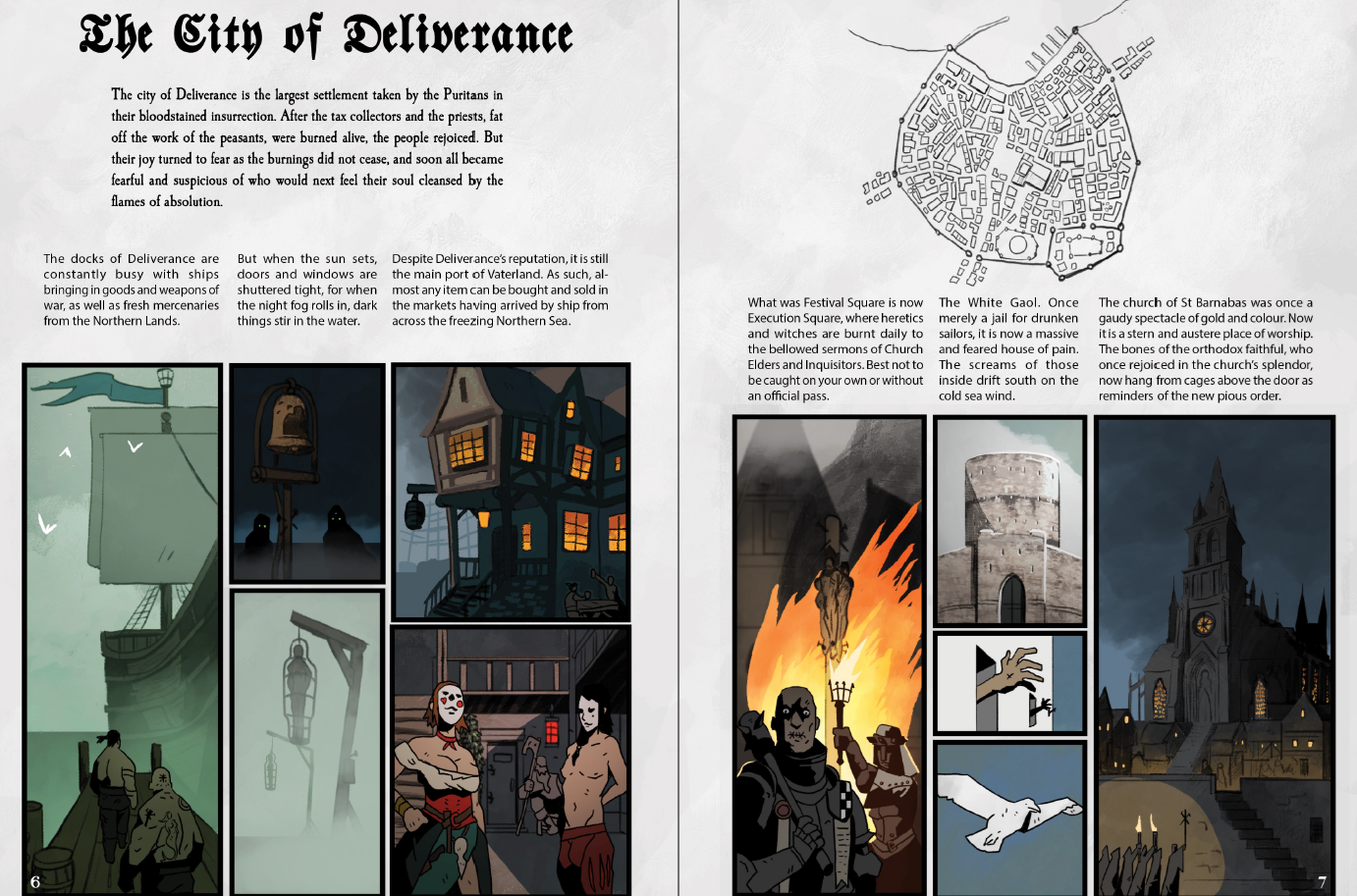
Setting
BPBR hews close to Warhammer Fantasy, but missing some of the nuance that made that setting work. Similarly, this is a medieval setting with demons and weird-magic stones taking place against a backdrop of religious extremism and early firearms. The main difference is that BPBR’s alternate history is much closer to our own, a fact that works strongly to the book’s detriment. See, Warhammer has many of the ephemera of our world, with gothic cathedrals serving the will of an expansive, multi-faction empire. The fictional nation of Vatreland has fantastical names right next to real historical ones; it takes many specific terms or groups but changes them, to a point where any knowledge you have of real history would make you more confused, not less, by reference. This creates both extra context and confusion, as you navigate where the differences lie. The Church does follow a shepherd who was martyred to make the church, and they do have a Vatican with a demon/witch hunting Inquisition and Crusades, but it isn’t actually Christian. Why not, if it’s that direct an analogy? A man named Luther Martin caused a schism in the church. The Inquisition exists, which works for and sometimes against the Puritans. Even though that holy Inquisition exists “only the Puritans actively persecute those who worship other gods”. This makes the setting hard to work with, as you sort out the real from fake.
Rest assured, there are plenty of evocative, weird horror adventure seeds, but it just doesn’t have the punch or brevity of Mork Borg. As you’ll see with the rules in the next section, the moment to moment writing lacks the poetry that would let you spin out deeper aspects of the setting on your own, but also lacks the specificity to develop those details. Overall, the style is lacking, and I cannot but think that this would benefit from some older vernacular or dialects to add flavor. Quick note: there’s a QR code that links to an inspiration playlist. I absolutely love this. It doesn’t fit into the art design at all, but this is a great move. Listening while writing this review created a tremendous, commendable vibe.
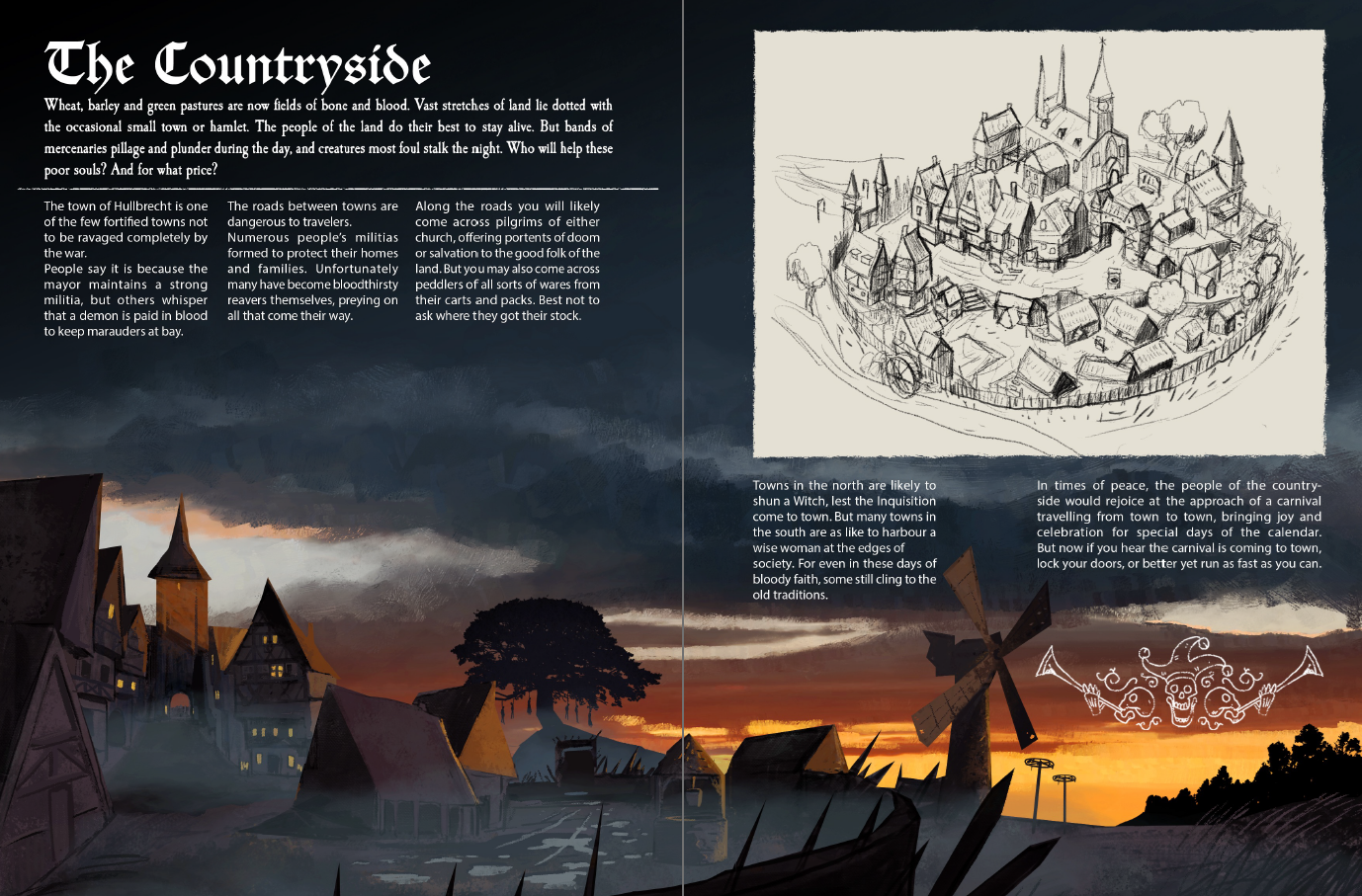
Mechanics
While the art and atmosphere are on point, the rules are the real issue. They’re the part you will spend most time with, and the part with the most consistent, fundamental problems. Mork Borg’s basics are pretty simple: characters have 4 stats (Strength, Agility, Presence, and Toughness). Most rolls are d20+Stat vs. 12. From there, the game has many tweaks or additions that could be great, but many of them are either underdeveloped, unusably written, or both. I’m going to dig more into the specific changes this makes to the rules, but as I do so you will see nigh-ubiquitous examples of the kind of thing I’m talking about.
The game adds Position and Impact, similar to Blades in the Dark. Functionally these are the severity of good or bad consequences, told to you before a roll. Whereas Blades builds these into the dice and math of its system, they are intended as general advice here. But to what purpose? Isn’t it a basic understanding of any dice roll that you can have good or bad consequences? Why use these rigid, systemic terms if you aren’t going to attach them to anything?
This may not be a substantive issue, but it does come into the Negotiation system, which involves changing dispositions of NPCs. The problem is that this really isn’t a social system. The only possible dispositions are hostile, neutral, and positive. They say most interactions are just a Presence roll, but this is different. How? Ostensibly because of Position and Impact, but there are no rules connected to those, they are just general principles. Why have this at all? There’s so little to these rules. All of the text on this page amounts to the basic idea that you can roll to change disposition.
Combat is basically the same as Mork Borg, with some extra maneuvers for more options. It’s nice in principle, but then you start reading those maneuvers. For instance, Stealth triggers when players “declare that they are doing something stealthy.” Don’t you mean when circumstances allow for it? Stealth puts a penalty to the players being noticed, but no bonuses for those in stealth, so what difference does it make that they haven’t noticed you? This is in the combat section, but is it intended to help you avoid combats? You can get a bonus for being well hidden, but we don’t know how much those bonuses should be.
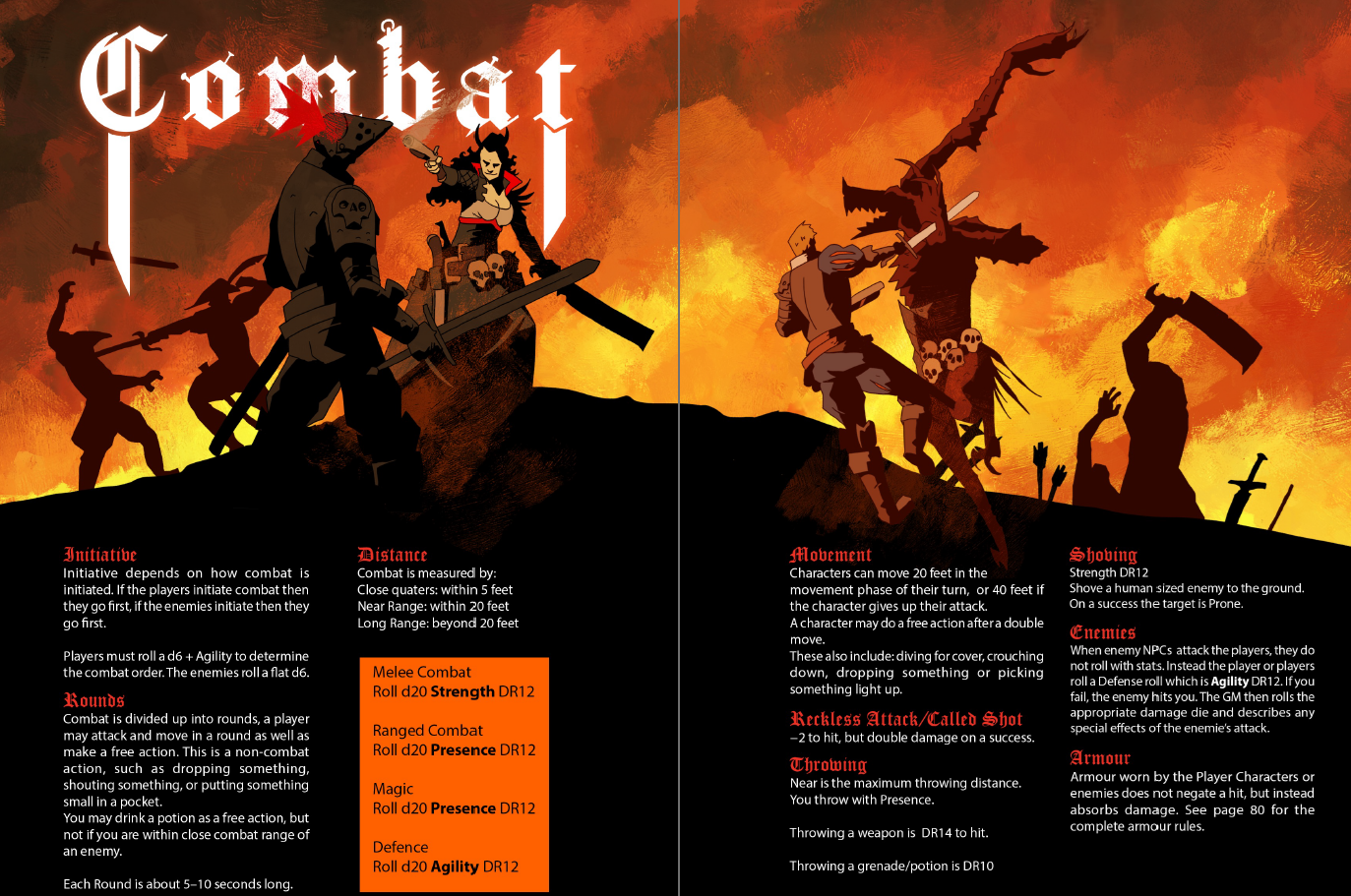
Otherwise, the maneuvers borrow things from 5E like attacks of opportunity and disengaging. The Fire rules say you can do nothing but take d4 damage as you flail and try to put the fire out, but doesn’t explain how you extinguish it. I guess that’s totally narrative? Height advantage states that you get +2 when “shooting and attacking an enemy in range from an elevated position.” How elevated do you need to be? Does that mean when you are shooting as an attack, or shooting or attacking? Grapple allows you to grapple or stun a creature if you succeed on a strength test. What is the difference between being Grappled or being Stunned? It isn’t mentioned at all here, or the summary tables, or the index. It is not in the book.
BPBS includes rules for mounted combat and chase rules with similar good ideas but critical, unanswered questions. They are overly simplistic to the point of not being engaging, but complicated to the point where that simple presentation doesn’t explain how they ACTUALLY work. Here’s the thing: Mork Borg is an elegant but simple game. Black Powder & Brimstone tries to add complexity while keeping MB’s general austerity, but without the finesse or clarity necessary to make that actually work. OSR generally gives more flexibility and less direction to the GM. It also usually gives you enough specifics that you understand certain basics of the rules that I find lacking here. What results is a game which has complexity that it doesn’t properly account for. Mork Borg knows exactly what to say and what to leave up to you. This game doesn’t.
I’m not going to go over every rule here, but rest assured that these problems are quite common. They have a section on special rules for crits. One of the results for melee attacks knocks the opponent down and says that creatures “must spend a turn getting up and are vulnerable to attacks of opportunity.” What does that mean? Does being vulnerable mean they take extra damage, or do they trigger attacks of opportunity while they stand up?
Character creation says you first roll your stats, and then pick an archetype. But archetypes change the way you roll those stats, so it should be first. Mercenaries roll “Normal Agility tests” at DC 14, a pretty serious penalty. But hang on, what differentiates Normal Agility tests from other ones? What other kinds are there? The Opportunist rolls “all” Agility tests at D10, so where does the difference come in? Is this an intentional schism or an oversight? I really can’t tell. I also can’t CTRL + F the document to check on any of these terms.
The archetypes have sub-archetypes, which come with their own problems. Riflemen, for example, can make bullets out of metal they have around. Well, how many bullets? How much time does it take? How much metal does it take? This isn’t just me nit-picking, this WILL come up in a game that asks you to track ammo. I’m not going to go over every example because this is a nigh-ubiquitous issue. This game is poorly written, in a way that will impact your sessions regularly. These aren’t ancillary rules; the problems impact basic, regular functions of your character. Look at this description of Firearms Repair Kit:
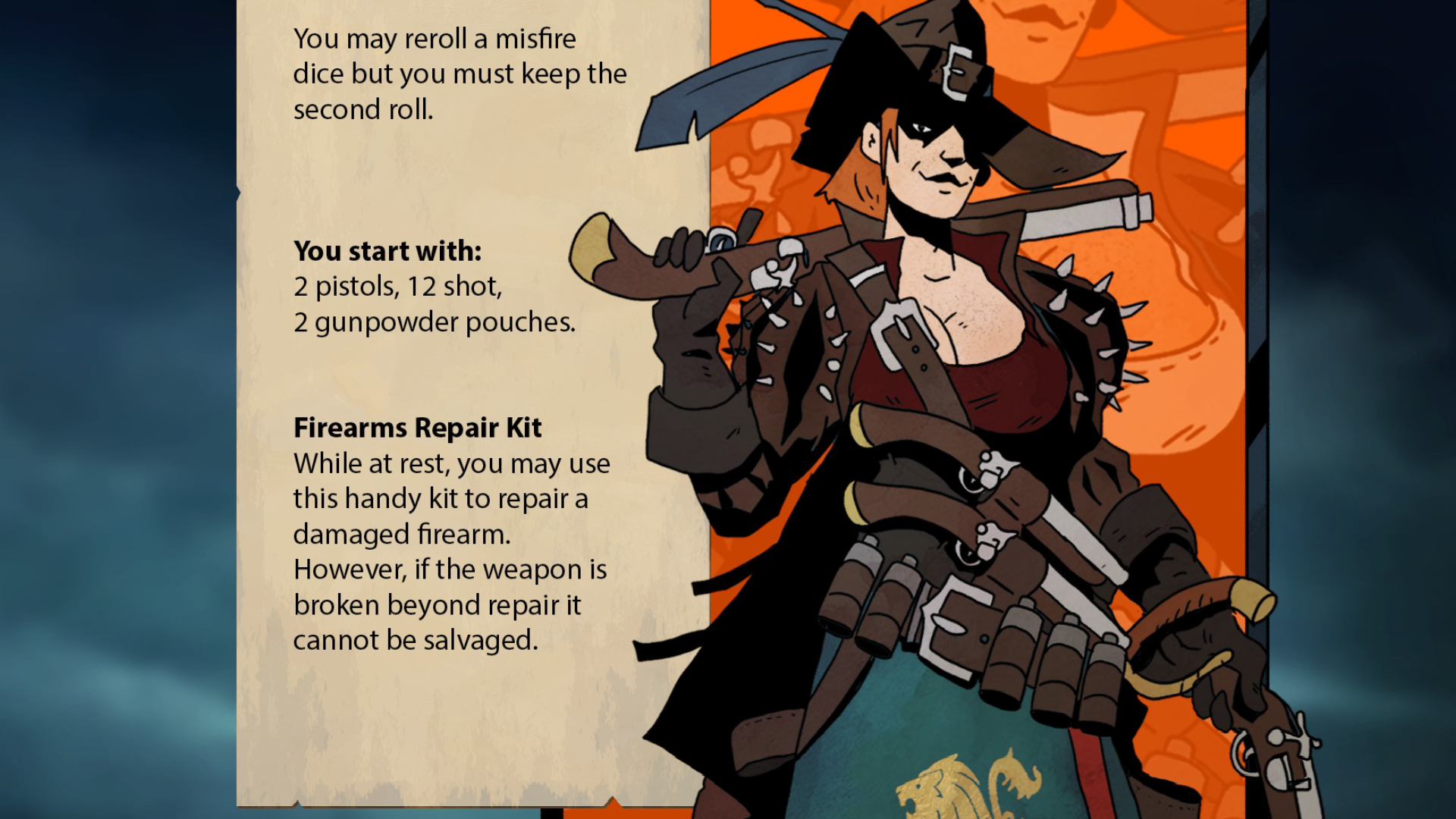
What’s the differentiating factor there? We usually understand that things broken beyond repair can’t…you know…be fixed. It’s right in the name. Why did you write it? No rules reference this in the game. Ben, I will do an editing pass on your next RPG for free. I promise. You may consider this a legally binding contract. Don’t publish a book like this.
The Master Trapper can find and make traps, but we don’t know anything about what materials they need or what time it takes. The only place with stats for traps is in the opening tables, but those only cover some of the traps. There are traps in the GM section, but those are different traps. Neither type are referenced in the index. The Sneak Thief has smoke bombs, which cover a 10 foot sphere and dissipate after a couple of seconds. But what do they do in that sphere? How many seconds? A round is 5-10 seconds, so “a couple of” could be under one round, or is this intended to last a full combat?
Look at this level up table.
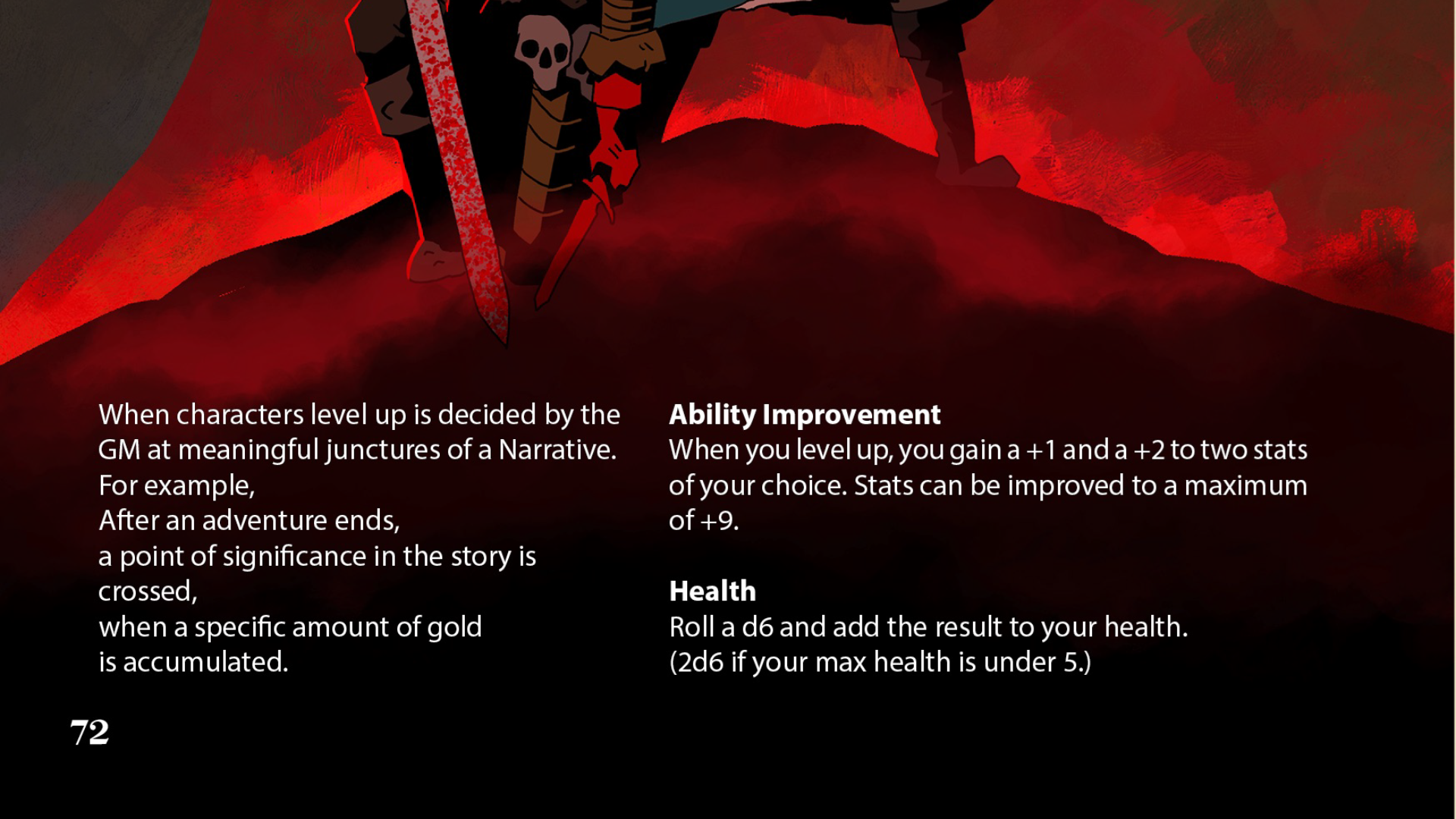
Let's ignore the bizarre spacing and focus on the text here. A specific amount of gold you say? HOW MUCH? You say it’s specific. Isn’t it? So what’s the number? If I set it myself, why bother mentioning it?
There are other specialized systems here, but I’m not going to go into them in detail. As you might suspect, they have similar problems as the other rules. You can gain one of a very few Feats. You can create a Free Company, which comes with mercenaries to help you. There is only one mercenary stat-block. It includes a musket, but the amount of ammo is unlisted. The HP rules imply that no one in the detachment can ever actually die. Weapons have special abilities, which are predictably so poorly written they make no sense. The Push Dagger’s “first attack gets +2 to hit”. First ever? First in a combat? First against a target? Also why? Why would a weapon get worse after one attack? The rules don’t say that it’s fragile, is it because it’s hidden? Does that mean entering stealth would give you a new bonus? There are pictures of weapons, but with nothing written on them, so you have to guess at which is which. They are sort of lined up like those in the equipment table, but not identically so.
Firearms roll an extra 1d8 on every attack. On a 1, they explode and hurt you, and misfire on a 2. What does misfiring mean? I don’t know. The book doesn’t say. Would you ever use a weapon if you have a ¼ chance of it being useless or actively hurting you? No. No you wouldn’t. Not when you have to take a round to reload them and they don’t do that much more damage than other weapons. They’re a fundamental aspect of the setting and many abilities, but you might well ignore them entirely. The Arquebus, one of the only 4 guns, is even worse. It asks you to roll a d6, explodes on 1-2, and misfires (whatever that means) on 3-4. And it says it deals damage to the "charater" not "character." That misspelling makes it into the book.
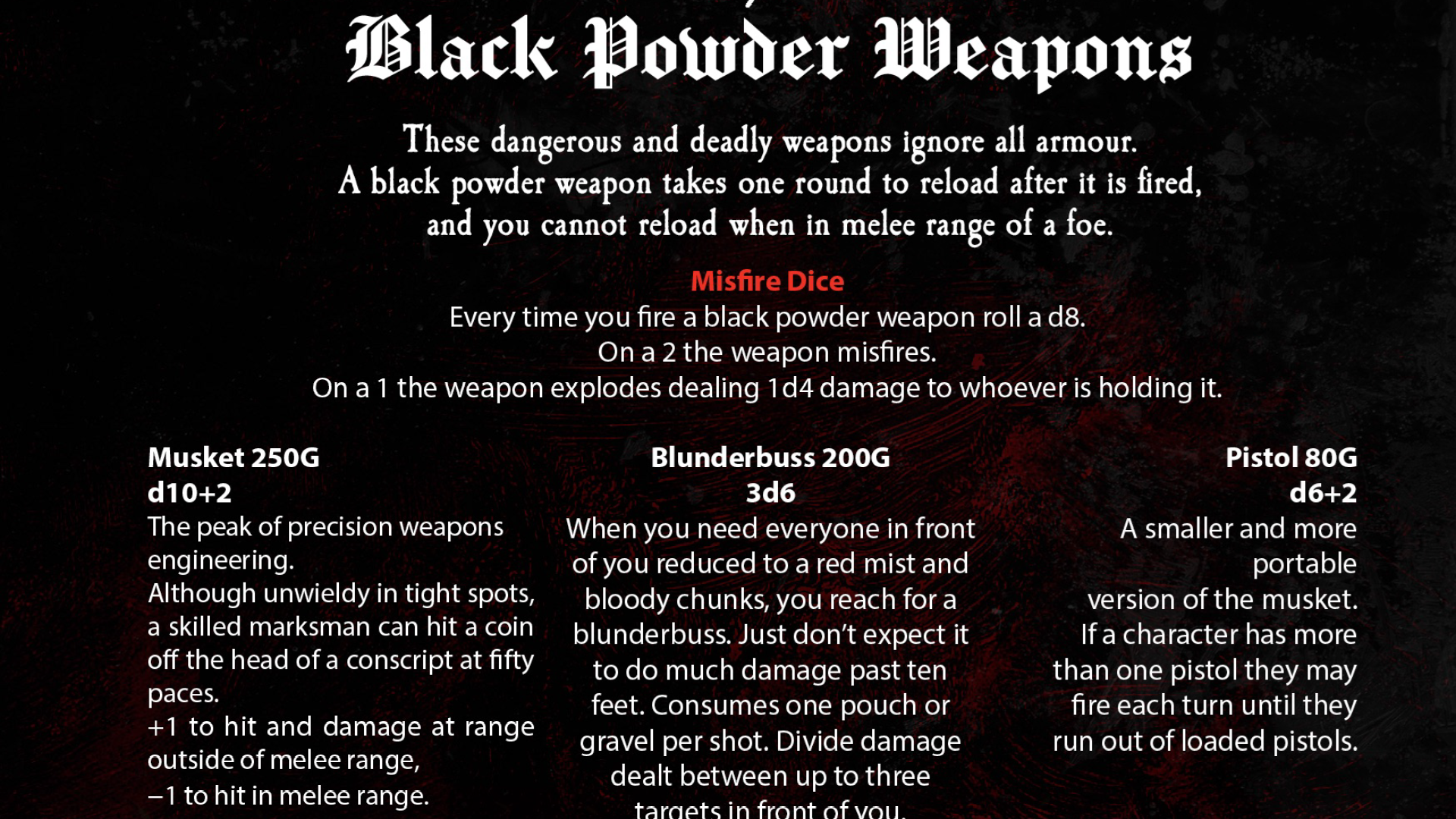
There are rules for armor, but not for putting armor on or taking it off. Those were definitely in Mork Borg.
Witches have special effects when they mark objects, but we don’t know what it takes to mark an object or what counts as an object. Do you paint it on? Do you have to touch the object? How big is an object? Could you explode a building? I don’t know. I don't need all of these questions answered in exhaustive detail, but I do need more than I have in front of me.
All of that is before we get to the GM section, which takes up most of the book. It starts with some refreshingly interesting secret lore and a lot of advice on structuring adventures. I found that advice acceptable, but so general I don’t know that the book benefits from this. There is much more text here, which forces the layout to suffer in some places. It starts bringing in clocks from Blades in the Dark in as a GM tool, which is actually a nice idea. Unlike Position and Impact, this is a simple tool you can attach rules to (each roll moves a clock) or not. However, being unbound from Position and Impact, you lose the ability to name running down the clock as Impact.
There are generators for adventures and NPCs and other elements, all of which might be useful but for the way they’re thrown into the text at random. Worse, parts of the adventure generator are sprawled out on multiple two page spreads. This makes room for cool art, but also means using them for an adventure would necessitate flipping through page after page for a few basic rolls.
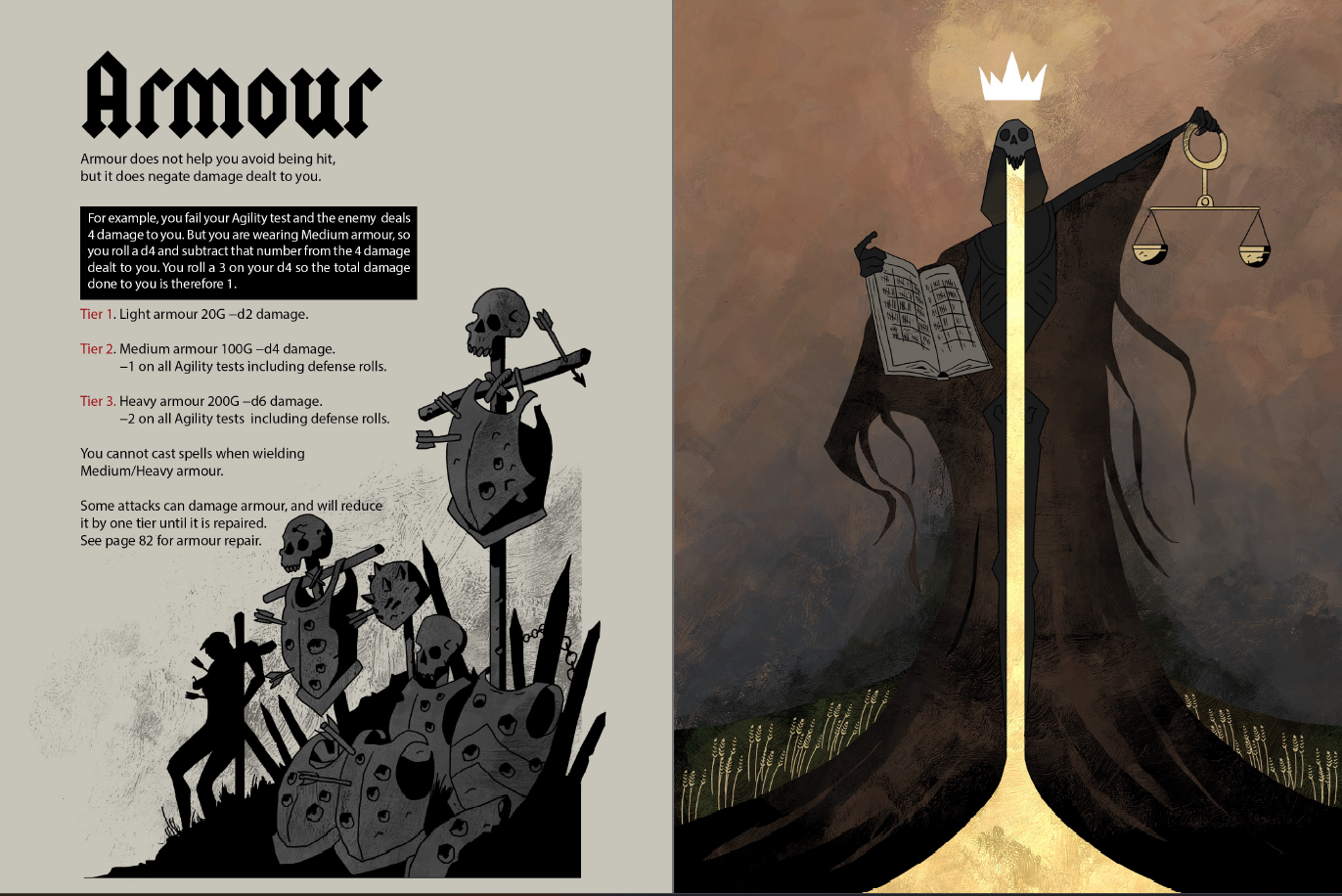
It concludes with a long Bestiary. This is the best part, because it’s a long excuse for the art with much less need for text to bog it down. It’s where the weird creativity, the aesthetic and tone, are most unleashed. This is the one part of the book you might be able to use, but you should do it with a different Mork Borg offshoot. Except that even then, it starts to mix in lore and setting details that make it hard to navigate in game.
There is an adventure at the end, but this is presented as a big list of places and people. It doesn’t tell the GM the story or goals. You have to read the entire thing over just to know the basics of what’s going on. The presentation is useful at the table, but not in prep beforehand.
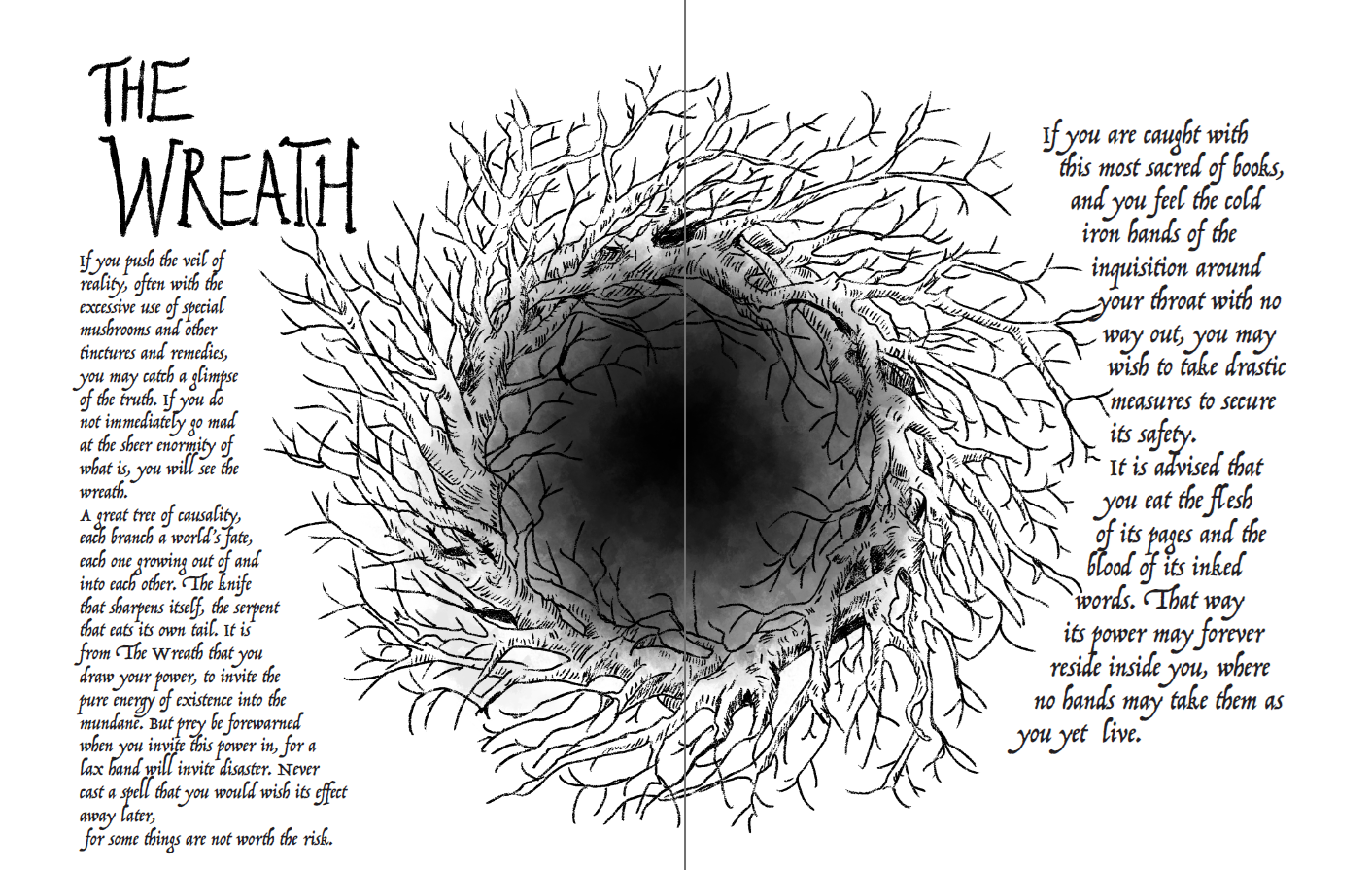
Book of Spells
The spells are listed in the book, but also in a separate Book of Spells which is a terrifying, lovely object (that happens to also be poorly written). It feels just like an ancient witch’s spellbook, replete with occult symbols and blood and scrawled ink penmanship on parchment paper. But the actual rules text comes with necessary, unanswered questions. As a few examples: Wound Eater - Target receives all damage dealt to you for d4 rounds. I don’t want a full D&D schematic, but what are the limits here? Can a target be anything? Does it have to be within line of sight? What if the target is destroyed? Obedience: a human target must obey a single simple command. What is a simple command? Does that mean the words you use are simple or the task is simple? How long does it last? Rot and Rust: target loses armor bonuses permanently. Does that mean for the current armor or for all armor they will ever use? It says they lose bonuses, but do they keep armor penalties? Is the armor destroyed or just useless?
Is the problem that I’m a lawyer who writes and amends laws, or do these spells leave too much room for interpretation? Am I losing my mind here?
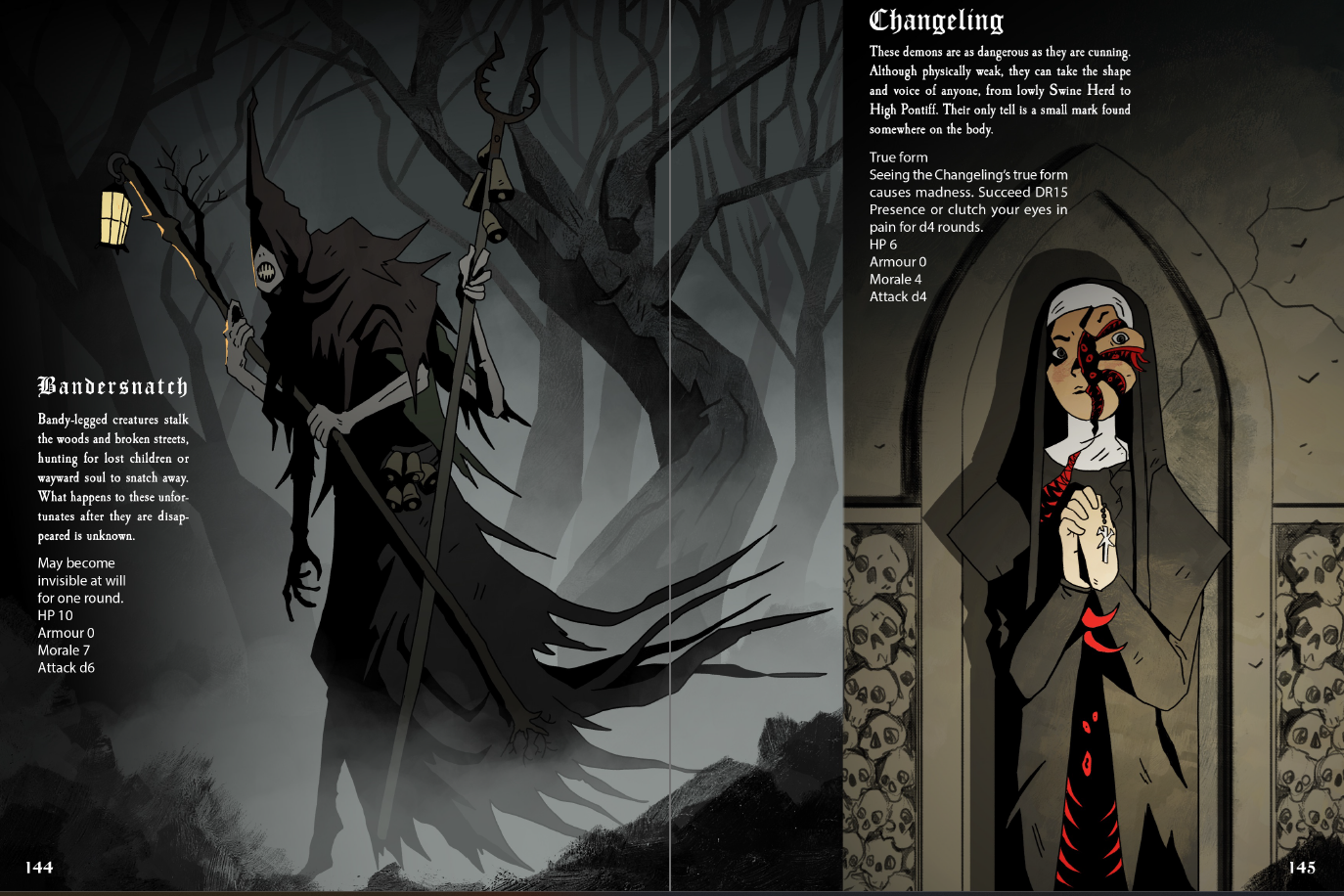
Conclusion
Look, I know that statement sounds snarky. I know this entire review does. I don’t like writing like this. Someone worked hard on this. Ben Tobitt put months to years of his life into this book. The art he created for it is absolutely magnificent, and I love the idea of every part of the setting and even rules. But all I can feel as I read it Black Powder and Brimstone is frustration at how the lack of care undercuts any potential. It fails rather consistently at many of the most important purposes it exists to serve. It’s a bad game. It is not, I must note, an unsalvageable one. A re-edited version of this could be magnificent.
Black Powder and Brimstone
Bad
I wish I liked this game. I’ve loved Mork Borg and, as you can tell from my review history, many of its offshoots like Pirate Borg or Death in Space. Black Powder and Brimstone’s lore and rules are full of confusing, poorly written sections that create more questions than they answer. Playing this game would put you in a place of constantly having to address details that are raised by the rules with no help or explanation. As an art book it’s phenomenal, but as a roleplaying game it’s a dud.
Pros
- The art and general atmosphere are fantastic
- The QR code playlist was a nice inclusion
Cons
- The rules are fatally unclear
- Melded alternate history/fantasy setting is constantly confusing
- The layout makes all of these issues worse
This review is based on a retail copy provided by the publisher.
